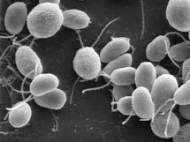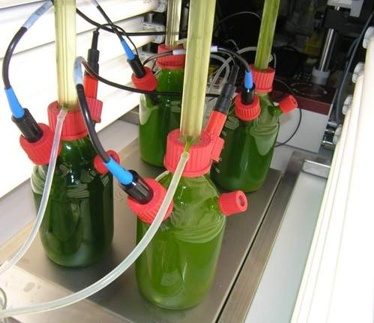Biosolar hydrogen production with green algae
 A fuel cell combines hydrogen and oxygen to produce electricity, heat, and water. In order to produce energy, fuel cells use oxygen and hydrogen. Hydrogen is high in energy, yet an engine that burns pure hydrogen produces almost no pollution. It’s also the most plentiful known element in the universe. Despite its simplicity and abundance, hydrogen doesn’t occur naturally as a gas on the Earth. However scientists have discovered how oxygen stops green algae from producing hydrogen. The findings could help those working towards “solar H2-farms” in which microorganisms produce hydrogen fuel from sunlight and water.
A fuel cell combines hydrogen and oxygen to produce electricity, heat, and water. In order to produce energy, fuel cells use oxygen and hydrogen. Hydrogen is high in energy, yet an engine that burns pure hydrogen produces almost no pollution. It’s also the most plentiful known element in the universe. Despite its simplicity and abundance, hydrogen doesn’t occur naturally as a gas on the Earth. However scientists have discovered how oxygen stops green algae from producing hydrogen. The findings could help those working towards “solar H2-farms” in which microorganisms produce hydrogen fuel from sunlight and water.
An international team of scientists from Oxford University and universities in Germany report their results in two papers, one in the journal JACS and one in PNAS, published this week. For years scientists have been interested in how we could, potentially, produce hydrogen from just sunlight and water to power vehicles and other devices. One option is to use photosynthetic microorganisms that are able to produce hydrogen as well as starch. Green algae are one of the microorganisms that many have suggested could be turned into living hydrogen factories. The team will shortly be publishing the results of similar research into nickel-iron hydrogenases, enzymes related to those that enable blue-green algae to produce hydrogen.
“The hydrogen-producing enzyme found in green algae, known as an iron-iron hydrogenase, has evolved a structure that makes it particularly susceptible to attacking oxygen molecules,” said Professor Fraser Armstrong from Oxford University’s Department of Chemistry, an author of both papers. “Because oxygen is a major by-product of the hydrogen-making photosynthetic process in such organisms, the build-up of oxygen, which rapidly attacks the active site of the enzyme, quickly brings the hydrogen-making process to an irreversible halt. Our work has revealed the mechanism of this process.”
The team used electrochemical kinetic methods to determine the order of events in which oxygen attacks the active site of an iron-iron hydrogenase found in the green algae Chlamydomonas reinhardtii. They combined their observations with data obtained from X-ray absorption spectroscopy. By measuring ripples in the photoelectron energy spectrum of the enzyme under X-ray bombardment they were able to deduce the nature of the damage caused to the active site following attack by oxygen.
Yet while the research reported in PNAS shows just how destructive oxygen is to the enzyme powering green algae’s hydrogen-making process, the team’s research reported in JACS shows that similar hydrogenases produced by other microorganisms may possess greater tolerance to oxygen, sufficient perhaps to survive in the presence of oxygen released during photosynthetic hydrogen production.
Professor Armstrong said: “It shows that whilst we may have found a major obstacle along one route to the biological production of hydrogen, this knowledge could help us to identify new routes where nature could suggest an answer to the problem of oxygen’s destructive effect on hydrogen-producing enzymes.”










Leave your response!